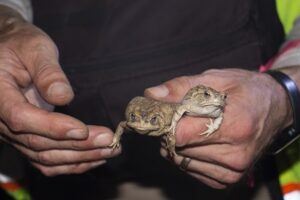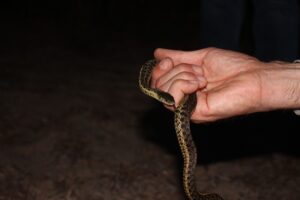PROVINCETOWN — A cloud of bug spray filled the air as 11 men and two women (including this reporter) followed Scott Smyers down the Old Colony Trail on the evening of July 7 to take part in one of Bear Week’s more unusual nighttime adventures: a nature walk.
Smyers is a herpetologist; his expertise is in amphibians and reptiles, not bears. He is vice president and a senior scientist with Oxbow Associates, a Boxborough-based environmental consultancy specializing in invertebrate investigations and studies of herpetozoan species.

It was just serendipity that Smyers looks like a bear, said William Mullin, president of the Provincetown Conservation Trust, which organized the walk.
Stephen Hengst, executive director of the Provincetown Business Guild, eagerly embraced the opportunity for a collaboration designed to take visitors beyond Provincetown’s bars and restaurants. “Get ready for an entirely new experience,” he told the walkers as they prepared to embark.
Outfitted with white buckets, sizable nets, and an infrared thermometer, Smyers earned praise from the crowd. “Oh, you’re prepared,” said Corey Healy, here from Brooklyn, N.Y., who was wearing little more than matching tie-dyed tee and shorts.
“I’m not exactly sure what we’re going to run into tonight,” said Smyers. “Let’s just go for a walk and see what we can find.”
It didn’t take long for the group to have its first wildlife encounter. Smyers, after observing a rustle in the bushes, sprang into action and captured a Fowler’s toad about three inches long. It was a mottled olive brown with a pale stripe down its back. He held the toad up for the others to see.
“This is a toxic animal with skin that can poison predators,” he said. Like other toads, Fowler’s produce milky toxins, known as bufotoxins, as a defense mechanism. Secreted from glands in their skin and heads, the toxins are relatively mild, though they can be irritating to the eyes or mucous membranes.
And if you find a Fowler’s toad, do not lick it. That will make you vomit, according to an article posted in the Wake, N.C. chapter of the National Audubon Society. Your dog can be sickened in the same way, according to the ASPCA.
The National Park Service last fall advised people not to lick Sonoran Desert toads, whose bufotoxins are more powerful than those of the Fowler’s toad and are sometimes abused as a drug, according to a Nov. 7 report in The Guardian. That kind of toad licking might be one way to get high, but it can also cause vomiting, seizures, or death, according to the report.
“I’ve actually seen a turtle eating a Fowler’s toad,” said Smyers. “The trick is to cut it open and eat from the inside out.

“Fowler’s toads, though common, fascinate me,” Smyers added. “They have a distinct whiny call and can grow quite large,” he said, rubbing the toad’s pale belly.
Dennis Minsky, a naturalist (and Independent columnist) who was along on the walk, said, “This toad must be wondering, ‘When exactly are you going to eat me?’ ”
Toads mate in amplexus — that is, the male clasps the female and awaits her eggs, releasing sperm on them as they are laid. “If you rub their bellies, that will get the male to start calling,” Smyers said. “They think they are on top of the females.”
From the huddled group, a voice said, “A very different kind of primal urge.”
Roland Coffey and Joseph DiMaggio, visiting Provincetown from Philadelphia for Bear Week, remembered childhood searches for turtle eggs. “When you’re a kid,” Coffey said, “you get to see so much more of the natural world.”
“As a kid, you’re a lot closer to the ground,” DiMaggio replied.
Eastern populations of box turtles have declined because of habitat loss, road kills, and pet collection, according to the Cape Cod National Seashore’s page on reptiles. But recent data suggest that the Seashore supports some of the densest populations of box turtles in the state. Smyers said chances were slim the group would come across any eggs, though. “They prefer to lay their eggs away from the trail where there is suitable nesting habitat,” he said.
Box turtles are “a species of special concern” in Massachusetts — not yet endangered but soon to be if stronger protection measures aren’t taken, according to Smyers.
As the last light faded from the trail, something slithered in the shrubbery. Smyers darted into the undergrowth and reappeared clutching a garter snake. Momentarily, a pungent odor wafted through the air.
“Snake farts!” someone said, prompting Smyers to explain that garter snakes release rank aromas as a defense mechanism against predators. He diverted attention from the smell by describing lessons learned in garter snake dissections. The snake’s lungs extend along the length of its body, he said. Also, “Garter snakes are live birthers, unlike most reptiles,” he said.
Smyers was unfazed by holding the reptile. “He’s not even trying to bite me,” he said. DiMaggio, initially eager to hold the snake, hesitated after learning that garter snakes — long thought to be nonvenomous — do produce venom, however mild and minuscule the amount. Smyers presented the snake’s midsection for DiMaggio to stroke instead.
Not everyone on the walk was as brave. First-time Bear Week visitor Tony Roman from Brooklyn said he doesn’t naturally take to wildlife. “Everything is trying to kill us,” he said.
Tim Ghani and Joseph Ciano were in Provincetown for Bear Week (though Ciano said, “We are not all bears”). Ciano spotted a daddy longlegs on a tall branch. Orb weaver spiders were abundant throughout the trek and flashlights illuminated their intricate webs.

Smyers had to use the iNaturalist app on his phone to identify a bush covered with white flowers: a deciduous swamp azalea, commonly found here near ponds.
“That’s a good drag name,” said Hengst.
Smyers said he finds the Old Colony Trail interesting because it has so many habitats in one small stretch, including swamps.
In his rubber boots, Smyers ventured into the murky waters of a white cedar swamp, dipping his net into the water, hoping to uncover something from its obscure depths. After some effort, he retrieved a baby fishing spider. These are large brown spiders with long legs that enable them to walk on water.
“It breathes out its butt,” he said. An entomologist might have put it this way: spider lungs are located on the abdomen.
Hengst asked everyone to turn off their flashlights to see the sporadic appearance of fireflies. After more than two hours of exploration, the group made its way back to the trailhead. A great tree frog called from above, its croak audible but its body concealed amidst the branches, eluding a glimpse.
Editor’s note: Because of an editing error, an earlier version of this article, published in print on July 20, incorrectly referred to the number of women who went on the herpetology walk with Scott Smyers. There were two: Sandra Chaet of Provincetown and reporter Georgia Hall, along with 11 men.



